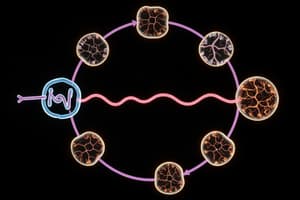Podcast
Questions and Answers
What happens to pyruvate dehydrogenase in cases of deficiency of pyruvate dehydrogenase phosphatase?
What happens to pyruvate dehydrogenase in cases of deficiency of pyruvate dehydrogenase phosphatase?
- It is dephosphorylated and becomes active.
- It is always phosphorylated and remains inactive. (correct)
- It converts glucose directly into pyruvate.
- It converts pyruvate into acetyl-CoA.
Which condition is associated with the deficiency of pyruvate dehydrogenase phosphatase?
Which condition is associated with the deficiency of pyruvate dehydrogenase phosphatase?
- Glucose intolerance
- Krebs cycle activation
- Acetyl-CoA accumulation
- Lactic acidosis (correct)
What are the anaplerotic reactions primarily responsible for?
What are the anaplerotic reactions primarily responsible for?
- Replenishing intermediates in the TCA cycle (correct)
- Converting lactic acid to glucose
- Breaking down intermediates in the TCA cycle
- Increasing ATP production
Which of the following best describes the Krebs cycle?
Which of the following best describes the Krebs cycle?
Which is NOT a consequence of pyruvate dehydrogenase phosphatase deficiency?
Which is NOT a consequence of pyruvate dehydrogenase phosphatase deficiency?
Which substances are replenished by anaplerotic reactions in the TCA cycle?
Which substances are replenished by anaplerotic reactions in the TCA cycle?
What is the primary effect of pyruvate always being phosphorylated?
What is the primary effect of pyruvate always being phosphorylated?
What role does malate play in the replenishing reactions?
What role does malate play in the replenishing reactions?
Which textbook is NOT suggested for further reading on this topic?
Which textbook is NOT suggested for further reading on this topic?
How does lactic acidosis affect the central nervous system?
How does lactic acidosis affect the central nervous system?
Flashcards
Krebs Cycle (Citric Acid Cycle)
Krebs Cycle (Citric Acid Cycle)
A series of enzymatic reactions that oxidize acetyl-CoA, producing ATP, CO2, and reduced coenzymes.
Cellular Respiration
Cellular Respiration
The process of converting nutrient energy into ATP for cellular work.
Pyruvate Dehydrogenase Complex
Pyruvate Dehydrogenase Complex
Enzyme complex converting pyruvate to acetyl-CoA, a critical link to the Krebs cycle.
Acetyl-CoA
Acetyl-CoA
Signup and view all the flashcards
Reduced Coenzymes (NADH, FADH2)
Reduced Coenzymes (NADH, FADH2)
Signup and view all the flashcards
Energy Yield (Krebs Cycle)
Energy Yield (Krebs Cycle)
Signup and view all the flashcards
Regulation of Krebs Cycle
Regulation of Krebs Cycle
Signup and view all the flashcards
Anaplerotic Reactions
Anaplerotic Reactions
Signup and view all the flashcards
Glycolysis to Krebs Cycle
Glycolysis to Krebs Cycle
Signup and view all the flashcards
Tricarboxylic Acid Cycle
Tricarboxylic Acid Cycle
Signup and view all the flashcards
Study Notes
Introduction to Krebs Cycle
- Also known as the Citric Acid Cycle or Tricarboxylic Acid Cycle.
- Discovered by Hans Adolf Krebs (1900-1981).
- A series of enzymatic reactions utilized by aerobic organisms to generate cellular energy.
Function and Importance
- Central metabolic pathway linking various metabolic pathways.
- Final oxidative pathway for metabolizing carbohydrates, proteins, and fats.
- Oxidizes acetyl CoA to produce CO2, H2O, ATP, and reduced coenzymes (FADH, NADH).
Cellular Respiration
- Process of converting biochemical energy from nutrients into ATP.
- Comprises three main stages, with the Krebs cycle as a key component.
Link Between Glycolysis and Krebs Cycle
- Pyruvate is transported from the cytosol to mitochondria.
- Oxidative decarboxylation of pyruvate forms acetyl-CoA, facilitated by the Pyruvate Dehydrogenase complex.
Pyruvate Dehydrogenase Complex
- Composed of three enzymes and five cofactors.
- Essential for converting pyruvate to acetyl-CoA.
- Deficiency leads to elevated lactate and pyruvate levels, potentially resulting in acidosis and neurological issues.
Cofactors and Their Deficiencies
- Key cofactors: Thiamine (TPP), Niacin (NAD), Riboflavin (FAD), Pantothenic Acid (CoA).
- Thiamine deficiency can cause neurological and cardiac disorders (Beriberi), impairing the oxidation of pyruvate.
Reactions of the TCA Cycle
- Step 1: Formation of citrate through a condensation reaction.
- Step 2: Isomerization to isocitrate.
- Step 3: Formation of α-ketoglutarate (α-KG).
- Step 4: Decarboxylation to succinyl-CoA, generating NADH.
- Step 5: Formation of succinate, producing GTP/ATP via substrate-level phosphorylation.
- Step 6: Conversion to fumarate, inhibited by malonate.
- Step 7: Hydration to malate.
- Step 8: Regeneration of oxaloacetate.
Energy Yield
- Overall reaction generates ATP and reduced coenzymes that drive ATP production in the electron transport chain.
- One cycle of the Krebs cycle yields a total of approximately 10 ATP from one acetyl-CoA.
Regulation of the Krebs Cycle
- Influenced by substrate availability (Acetyl-CoA and oxaloacetate).
- Inhibition by accumulating products and allosteric feedback, particularly a high NADH/NAD+ ratio.
- Covalent modifications can also impact enzyme activity.
Amphibolic Nature
- Serves both catabolic (energy-producing) and anabolic (biosynthetic) functions.
- Involves anaplerotic reactions that replenish intermediates to maintain metabolic balance during varying demands.
Replenishing Pathways
- Specific reactions that restore TCA cycle intermediates, ensuring its continuous operation even when intermediates are diverted for biosynthesis.
Suggested Reading and Resources
- Recommended textbooks include "Lehninger Principles of Biochemistry," "Biochemistry" by Lubert Stryer, and "Biochemistry for Sports and Exercise Science."
- Online videos for visual learning are beneficial.
Studying That Suits You
Use AI to generate personalized quizzes and flashcards to suit your learning preferences.




